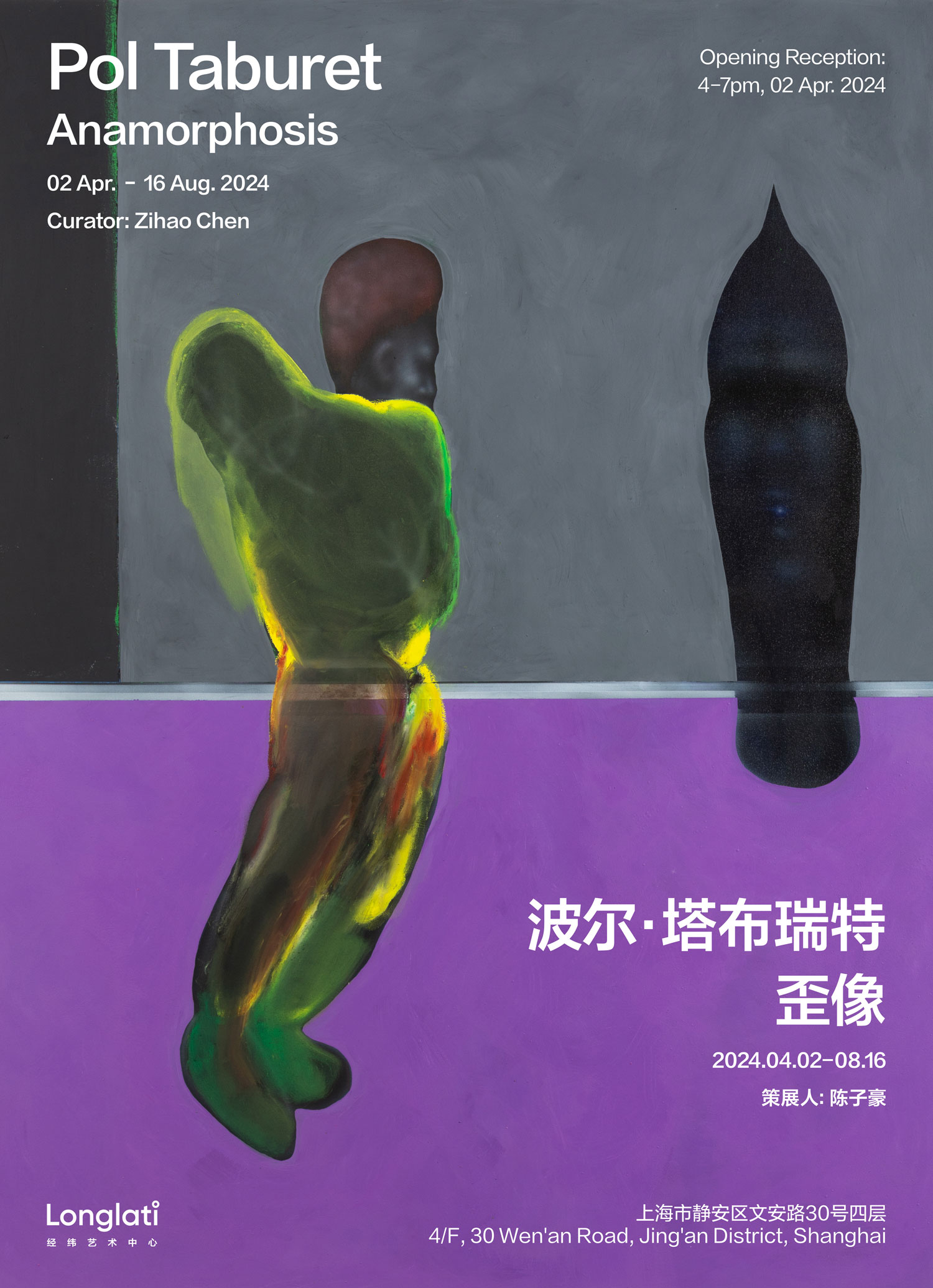展期 Period:
2024.4.2—2024.8.16
艺术家 Artist:
策展人 Curator:
地点 Venue:
Longlati经纬纬艺术中心 Longlati Foundation
新闻稿 Press Release:
由Longlati经纬艺术中心呈作的波尔·塔布瑞特(Pol Taburet)“歪像”是作为文安路新空间开馆展的个像研究之一,行将特别展出波尔·塔布瑞特近一年创作的架上绘画与装置作品,该展览同时也是波尔在亚洲的首次个人展览。
1997年生于巴黎的波尔·塔布瑞特试图将技法和效果融合,并尝试通过大量媒介和实验性视觉进行创作,来展示自己对艺术内在的渴望。在他的绘画作品中,具象描绘散发着一种可被感知的空灵感,一种“灵魂文化”从朦胧的身体意象中缓缓渗透。这种独特的审美体验根植于艺术家的记忆,是代代相传的民间传说、流行文化和艺术史之间相互融鉴与升华的表现。从非洲加勒比神话中所汲取的人面兽身和原始巫术的灵感,通过数字编辑和意大利文艺复兴时期的经典建筑相融合,其指向性特征尤为明确。《小巷》(2023年)中叛逆地以红、黄、绿作为空间分割、怒目的脸庞隐匿在乌木中,被定格的瞬时状态是波尔对记忆也是对时间性的回溯。
波尔将自己的绘画称为是一种“爵士”式的工作方式,它植根于即兴表达,不受任何草图的预设和色彩的限制。波德莱尔在《1846年沙龙》(“Salon of 1846”)中指出:“浪漫主义关注如何表现艺术家的感觉,以及感受特定的方式......对于我来说,浪漫主义是对美的最新的、最现代的表达”,这或许也是对波尔自诩为“新浪漫主义者”(Neo-Romantic)的阐释。
在架上创作的同时,雕塑以及近期对装置艺术的探索也是波尔对媒介探索的另类呈现。与绘画中似是而非的原始欲望不同,装置作品中对于脸庞的描摹清晰可见。《哦!树》(2024年)是波尔通过3D扫描伴侣的面孔进行二次创作的雕塑,以现代性的叙事延伸出另一种形式的狮身人面像。而在系列作品《喷泉》(2024年)中,喷泉在神话故事中映射着生育与不朽,圆柱让人浮想到希腊神话中的爱与美神阿佛洛狄忒。浪漫主义叙事与雕塑写实主义之间的断裂,一同构成了波尔对新媒介的探索。喷泉光滑的外表上做旧的斑驳锈迹,暗示着可能隐藏在物内部的潜在生命。
展览将雕塑作品巧妙地置于一隅幽静之地,它们静静地矗立,引导观众在它们面前进入这场无神的讨论,却又仿佛远古神祗俯视着众生。这些雕塑既是现实的实体,又是一场梦境中的幻影,是潜意识中那些被时间遗忘、在空间中被封存的启示录。每一件作品都以其熟悉而又神秘的形态,诱惑着观者深入记忆的迷雾之中,探寻那些被忽略的细节,试图解读这些静默的造物之间交织的对话。波尔将他邂逅上海苏州河边文安路30号这座百年历史建筑的记忆视为塑造这场展览的关键,新与旧、历史与当下的有形辩证,在展览中交织出充满赛博朋克色彩的超现实幻境。
“歪像”不仅述说波尔画面本体上对人物造型的处理方式,同时也透露出隐藏在波尔创作背面的故事体系。从古老的传承到当下的描绘,从神话的引喻到现世的摹写,这些个体的双向性特征都能被艺术家以特定的书写方式呈现于同一界面上。
"Pol Taburet: Anamorphosis," curated by Longlati, represents one of the individual exhibitions proposed for the opening of Wen'an Road's novel space. The exhibition promises to feature an exclusive presentation of French artist Pol Taburet 's recent artworks, encompassing paintings and installations crafted over the past year. It also marks the artist's premiere solo exhibition within the Asian continent.
Born in 1997 in Paris, Pol Taburet, showcases his multifaceted artistic production through a large corpus of artworks presenting his material and visual experimentations, characterized by an innate desire to blend techniques and influences. In his pictorial compositions, figurative depictions emanate a discernible ethereality, with subtle hints to "soul culture" delicately permeating the nebulous corporeal imagery. This peculiar aesthetic is rooted in the artist's mnemonic reservoir, where generational memories, folklore tales, pop culture, and art history combine and multiply each other without hierarchy. Anthropomorphic hybrids and evocative tropes of sorcery are drawn from African Caribbean mythos to be remixed with video clip's imagery and architectural details reminiscent of Italian Renaissance classics to form a narrative fabric redolent with thematic clarity. For instance, in his piece "The Alley" (2023), characterized by subversion of spatial boundaries through a riotous palette of red, yellow, and green, alongside a visage of simmering defiance concealed amidst the ebony shadows, Pol Taburet undertakes a poignant exploration of memory and temporality.
Taburet sometimes evokes "jazz" musical composition as a similar methodology to his approach to artmaking, grounded in spontaneous expressionism and liberated from the constraints of preparatory sketches or predetermined color schemes. In his essay "Salon of 1846," Baudelaire contends, "Romanticism concerns itself with the artist's emotions and experiences in a particular manner... Romanticism is the latest and most modern expression of beauty." This assertion may elucidate Pol Taburet's self-ascription as a "Neo-Romantic."
Concurrent with his painterly pursuits, Pol Taburet has also embarked upon an experimental foray into sculpture and, recently, installation. In contrast to the enigmatic primal impulses inscribed upon his canvases, his installations exhibit a lucidity of facial portraiture. For instance, "O' Trees" (2024), a sculpture derived from a 3D scan of Pol's partner, is an instantiation of his innovative approach towards mythopoetic narratives, extending the tradition of the sphinx through contemporary modalities of storytelling. Likewise, in the series "Fountain" (2024), the titular motif, replete with mythic signification concerning fecundity and immortality, evokes parallels with the Greek deity Aphrodite, thereby exemplifying the dialectical interplay between Romantic narrative and sculptural realism that defines Pol's exploration of new media. The patina on the surface of "Fountain," suggests the passing of time and moreover hints to possible life hidden at the heart of the object.
The exhibition displays the sculptures in separate, intimate spaces, as to involve the viewers in silent discussions while towering over them like distant deities. They appear as both inhabited and hallucinated objects, unconscious revelations suspended in time and captured in space. The familiar yet enigmatic shapes of the artworks invite to search for forgotten details within our memories to try to understand the dialogues between these inert manufactured creatures. The artist evokes his initial encounter with the historic edifice located at 30 Wen'an Road by the banks of the Suzhou River in Shanghai as decisive for the construction of the exhibition. The tangible dialectic of antiquity and contemporaneity, of history and the present influencing the cyberpunk-inflected surrealist atmosphere of the show.
"Anamorphosis" not only serves as a testament to Pol's idiosyncratic treatment of figuration but also unveils the latent narrative substratum that underpins his creative production. From the hallowed annals of tradition to the quotidian tapestry of contemporary life, from mythopoeic allusions to prosaic observations, Pol's corpus embodies a dialectical duality that finds expression through a singularly crafted narrative discourse.

